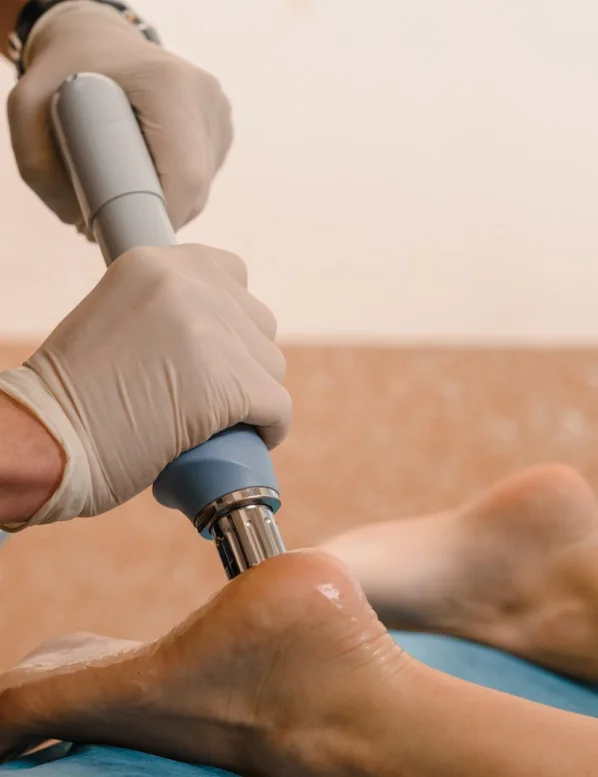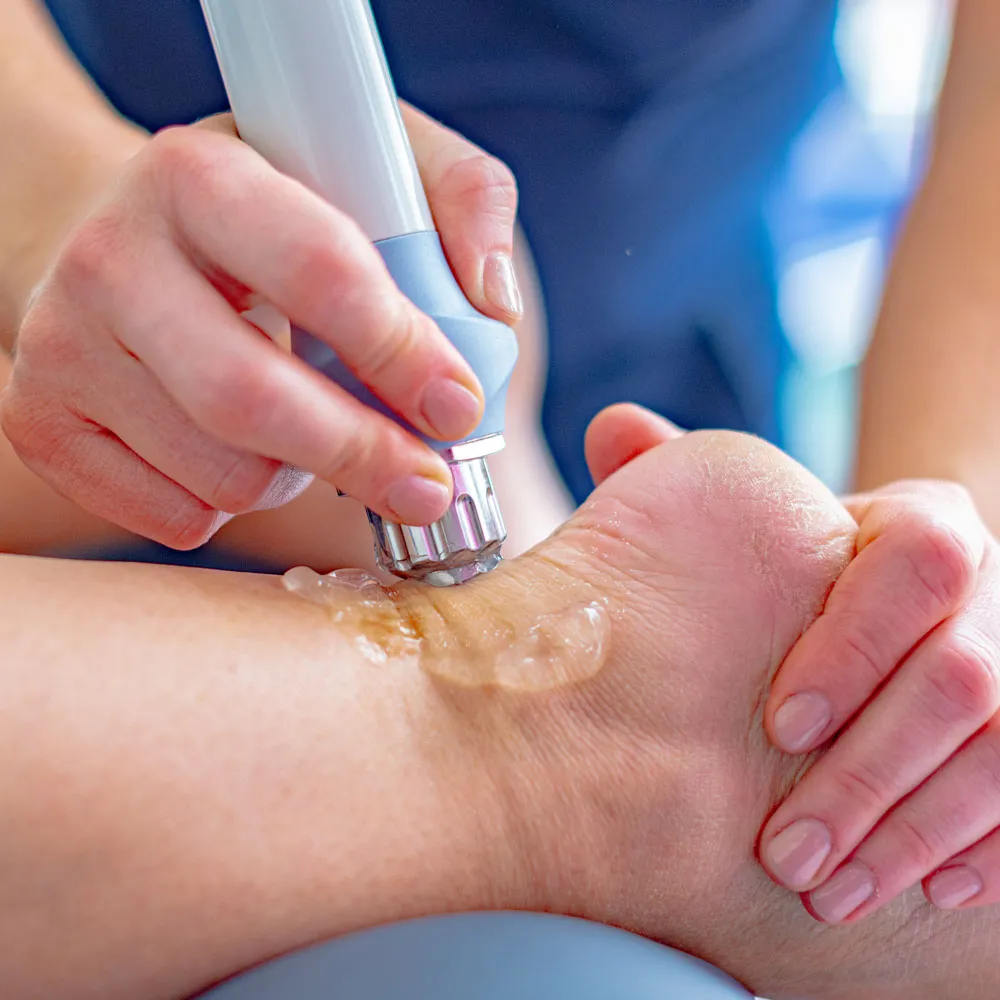Many of us probably have the question, “How does shockwave work?” and how is it possible for it to help with so many things? Let’s explore the science behind this increasingly popular therapeutic method. Shockwave therapy stands out as a non-invasive therapeutic approach that is becoming widely recognized for its efficient treatment of musculoskeletal conditions, which mainly affect tendons and chronic pain. The therapy achieves tissue healing by using acoustic waves that reverse inflammatory processes and boost circulation to the treatment zone while simultaneously stimulating cellular growth. The worldwide application of shockwave therapy as a physiotherapy method treats both short-term and long-term medical problems while delivering enduring relief to patients who suffer from numerous injuries.
The following article explains shockwave therapy methods and their numerous applications and scientific evidence for curing tendonitis and plantar fasciitis and calcific tendinopathy alongside other illnesses.

The practice of shockwave therapy requires medical practitioners to direct high-frequency sound waves toward specific target tissues. The produced sound waves generate pressure waves that activate the target tissues to enhance blood flow and minimize pain symptoms while speeding up recovery time. The procedure needs multiple continuous appointments to deliver optimal outcomes yet remains a non-invasive treatment choice.
Shockwave therapy establishes its effects by activating the body’s intrinsic healing processes. The process stimulates collagen production, thereby enabling tissue repair and speeding up the regeneration process of tendon fibers and muscle tissues. The therapy proves particularly useful for persistent injuries unresponsive to typical methods, including rest combined with medication.

The therapeutic effectiveness of shockwave therapy stands strong when treating tendonopathies and musculoskeletal problems among patients who did not respond to traditional therapies. The following conditions receive treatment through shockwave therapy among common medical cases:
Athletes, especially those who run, often experience Achilles tendonitis as an overuse injury during athletic activities. Repeated stress on the Achilles tendon results in lower leg pain together with stiffness and inflammation as a primary cause of the condition.
How Shockwave Therapy Helps:
Evidence: Patients with Achilles tendonitis showed both functional improvement and decreased pain, according to research conducted by Rompe et al. (2007).
Athletes who play jumping sports such as basketball, volleyball, and soccer develop patellar tendonitis most frequently. The patellar tendon beneath the kneecap suffers from swelling and discomfort in this condition.
how does shockwave work for
Medical studies show that shockwave treatment helps mend the patellar tendon structure, thereby providing a better treatment option than surgery or corticosteroid injections for persistent cases.
Plantar fasciitis stands as the primary reason behind foot-related heel pain. When the plantar fascia suffers from excessive strain at the bottom of the foot, plantar fasciitis develops.
How Shockwave Therapy Helps:
Evidence: Data from Cacchio et al. (2006) showed shockwave therapy delivered better results compared to standard physiotherapy since patients experienced enhanced pain reduction in combination with enhanced walking ability.
The condition known as calcific tendinopathy leads to calcium buildup that occurs most often in the rotator cuff of the shoulder. The calcific accumulation within tendons produces both pain together with inflammation as well as muscular restriction.
How Shockwave Therapy Helps:
Evidence: Scientific research shows shockwave therapy functions as an optimal therapy for treating calcific tendinopathy, thus avoiding surgical solutions. Shockwave therapy accomplished the removal of calcium deposits, and it enhanced shoulder function, according to Rompe et al. (2010) in their analysis of numerous patients.
Aggravation of rotator cuff tendons occurs from repetitive overhead motions alongside aging effects and injuries. Rotator cuff injuries trigger shoulder-related pain as well as diminished shoulder strength.
How Shockwave Therapy Helps:
Evidence: Research shows that shockwave therapy, together with physiotherapy exercises, enables patients to recover faster while improving their rotator cuff function.
The two conditions form because repeated stress affects tendon structures within the forearm muscles while causing elbow area discomfort.
How Shockwave Therapy Helps:
Evidence: Research has validated the superior effectiveness of shockwave therapy over corticosteroid injections for persistent tennis and golfer’s elbow treatment.
Bone marrow edema develops as a painful condition when fluids build up inside bones due to traumatic injuries, osteoarthritis, or inflammatory events.
How Shockwave Therapy Helps:
Evidence: The research conducted by Kang et al. (2018) demonstrated shockwave therapy minimized pain while restoring bone marrow edema area dimensions in patients with knee osteoarthritis.
The outer part of the hip, known as the greater trochanter, experiences an ailment named Greater Trochanteric Pain Syndrome (GTPS). This condition leads to painful and tender sensations in the designated area. GTPS occurs frequently alongside gluteal tendinopathy or bursitis, which makes daily mobility and normal activities difficult for patients. People within middle age, along with runners and people who have unstable hips, commonly suffer from GTPS.
How Shockwave Therapy Helps:
Evidence: Evidence shows shockwave therapy works to reduce pain along with enhancing functional abilities in GTPS patients, thus remaining the preferred treatment choice over surgery.
Shockwave therapy stands as a fundamental therapeutic strategy for many musculoskeletal problems, especially ailments of tendons and ongoing pain conditions. Shockwave therapy has gained status as the top choice for physiotherapists who treat Achilles tendonitis along with patellar tendonitis, plantar fasciitis, calcific tendinopathy, and rotator cuff injuries because it effectively promotes tissue regeneration while reducing inflammation to achieve healing outcomes.
Evidence is mounting that shockwave therapy works as an effective non-invasive solution that treats acute and chronic musculoskeletal disorders. Shockwave therapy provides an optimistic treatment route for pain relief with added benefits for faster recovery so athletes with tendonitis along with chronic pain patients can both experience benefits from this therapy.
Assessment by a qualified physiotherapist remains essential before selecting shockwave therapy because they will evaluate your condition to determine its suitability.
Read more about How Shockwave Works for Shoulder Calcific Tendinitis– All You Need To Know In 2026